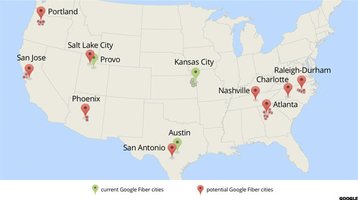The ongoing high-speed internet project piloted by Google unveiled plans to expand into four metropolitan areas in the Southeastern US during the coming year. The company announced yesterday that it will begin designing and constructing its high-speed network in 18 cities across four metro areas, including Atlanta, Charlotte, Nashville, and Raleigh-Durham.
The planning process has been in motion for more than a year, wrote Dennis Kish, VP of Google Fiber, in a blog which gave more details about the expansion.
“Our next step is to work with cities to create a detailed map of where we can put our thousands of miles of fiber, using existing infrastructure such as utility poles and underground conduit, and making sure to avoid things like gas and water lines”, Kish said, adding that “a team of surveyors and engineers will hit the streets to fill in missing details.” The Google Fiber VP said network design should be completed within a few months, at which point construction will begin.
Need for speed
Google Fiber claims speeds up to 100 times faster than the basic broadband Internet connection available in most regions of US, enabling a Gigabit of data per second both upload and download. Google began the initiative five years ago as a pilot project in Kansas City, and has since expanded to Provo, Utah, and Austin, Texas. The project, Google has previously asserted, is necessary to promote innovation and economic growth across the country.
In an interview with the Financial Times, Kish acknowledged some setbacks for the project thus far. Although the company plans to accelerate expansion of its fiber network, Google exec told the newspaper that local authorities need to facilitate access rights to current infrastructure such as utility polls and underground conduits, in order to speed up deployment of higher-speed optical fiber.
Of course Google has a financial incentive in laying new fiber networks, as it will be charging for most of the services it delivers. But by doing so it is also may create a competitive market for broadband services in areas limited to just a few or even a single carrier. The increased competition has the potential to affect pricing or require that competing providers upgrade their own infrastructure to compete with Google’s speed and price points.
Kish also promised an update later this year on further expansion, as the company examines Phoenix, Portland, Salt Lake City, San Antonio, and San Jose as future locations for Google Fiber networks.

